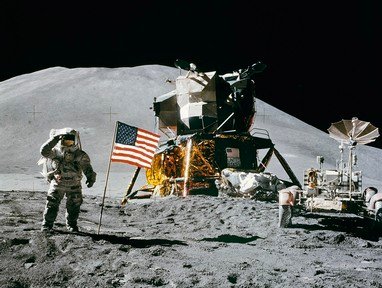Quiz Answer Key and Fun Facts
1. The first crewed Saturn V flight immediately had an ambitious mission profile: Take three astronauts into orbit around the Moon and back to Earth. The astronauts also brought home a famous photo that still awes viewers more than fifty years later. What is its title?
2. As Apollo 9 never flew to the moon, we will skip to Apollo 10, effectively a dress rehearsal for the actual landing. In fact, the astronauts came within ten miles of the lunar surface. Could they have actually stepped on the moon?
3. In one of the most famous moments of spacefaring history, Neil Armstrong planted an American flag on the moon shortly after stepping onto the lunar surface. How long did this flag remain standing and displaying the US colors?
4. Apollo 12 did not only retrieve lunar soil samples, but also brought back to Earth a very different kind of material. What was it?
5. It is well known that Apollo 13's near disaster was caused by an explosion in an oxygen tank. In which component of the spaceship, however, was that tank located?
6. The most memorable moment of Apollo 14 was probably Alan Shepard's lunar golf practice, but lunar module pilot Edgar Mitchell also performed a sport on the moon. What discipline did he emulate?
7. Apollo 15 triggered a scandal which came only to light about a year after the mission had ended. It revolved around items - a total weight of about 850 grams - that the astronauts had taken to the moon and back without authorization. What kind of items were they?
8. Apollo 16 was probably the least remarkable of the six missions that actually landed on the moon, but it did return the largest single rock from the lunar surface that any mission has brought back. What is its name?
9. Apollo 17 was the third mission to use a lunar rover and set the speed record for a wheeled vehicle operated outside Earth. To which speed did Eugene Cernan, the driver of the rover, manage to push it?
10. Twenty-four astronauts flew to the moon on the nine Apollo launches that got there (three flew twice) and twenty-one of them indeed had a wife to love to the moon and back. One never married, one only found love after his flight. However one astronaut could not claim to love his wife to the moon and back because he got a divorce before the mission. Which of the following four astronauts DID love his wife to the moon and back?
Source: Author
WesleyCrusher
This quiz was reviewed by FunTrivia editor
ponycargirl before going online.
Any errors found in FunTrivia content are routinely corrected through our feedback system.
